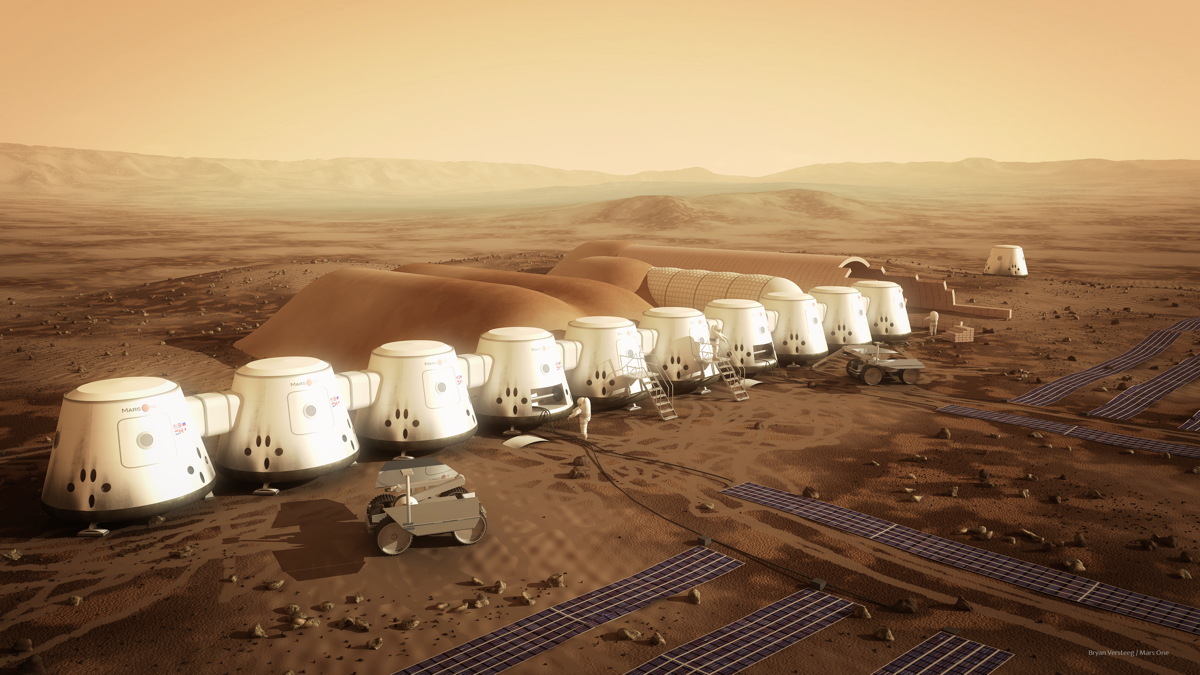
Organizers of a private Mars colonization effort may have to rethink their ambitious plans, a new study reports.
An analysis led by students at the Massachusetts Institute of Technology (MIT) has identified a few purported problems with the blueprint laid out by the Netherlands-based nonprofit Mars One, which aims to land four people on the Red Planet in 2025 as the vanguard of a permanent settlement.
"We're not saying, black and white, Mars One is infeasible," study co-author Olivier de Weck, a professor of aeronautics and astronautics and engineering systems at MIT, said in a statement. "But we do think it's not really feasible under the assumptions they've made. We're pointing to technologies that could be helpful to invest in with high priority, to move them along the feasibility path." [Mars One's Red Planet Colony Project (Gallery)]
For example, Mars One aims to source the colony's drinking water on-site by baking Red Planet soil, which is known to harbor water ice, at least in some locations. But the technology needed to do this is not yet ready to fly on a space mission, study authors said.
Furthermore, the new analysis suggests that growing crops within settlers' habitats, as Mars One envisions, would generate enough oxygen to make the living spaces a fire hazard.
Piping in nitrogen could lower the oxygen to safe levels, researchers said, but this fix would likely deprive the colony of a vital gas needed to compensate for leakage into the surrounding Martian atmosphere. The possible end result? A space that would quickly become unlivable, suffocating colonists after about 10 weeks, the study found.
There are ways to prevent this scenario — growing food in isolated greenhouses, for example, or implementing an oxygen-extraction system. But the best alternative is to nix the idea of Mars farms and bring all the colony's food from Earth, the study determined.
Get the Space.com Newsletter
Breaking space news, the latest updates on rocket launches, skywatching events and more!
"We found [that] carrying food is always cheaper than growing it locally," said study lead author Sydney Do, an MIT grad student. "On Mars, you need lighting and watering systems, and for lighting, we found it requires 875 LED [light-emitting diode] systems, which fail over time. So you need to provide spare parts for that, making the initial system heavier."
The team also calculated that Mars One would probably need to launch a large quantity of spare parts in the early going, since resupply missions can blast off only once every 26 months, when Earth and the Red Planet are favorably aligned.
And the study concluded that 15 launches of SpaceX's Falcon Heavy rocket would be needed to get the colony set up for the first settlers' arrival — far more than the six that Mars One has envisioned. Therefore, the multibillion-dollar project may end up being more expensive than Mars One representatives have estimated. (The group intends to pay most of its bills by staging a global media event around the colonization effort.)
Mars One is standing firmly behind its plans, however.
"The mission design has been discussed with engineering teams from aerospace companies like Paragon Space Development and Lockheed Martin," Mars One co-founder and CEO Bas Lansdorp told Space.com via email. "These engineers have actually been building these systems, and each team we talked to is leading in the world. Our current mission design is the result of our own studies and their feedback, and we are very confident that our budgets, timelines and requirements are feasible."
Lansdorp said he's glad that the Mars One project has inspired students to investigate the prospect of colonizing the Red Planet.
"While students can probably not do better mission assessments than experts, they do tend to come up with very original ideas which are required for new developments," Lansdorp said.
Do and de Weck presented the results of the new study earlier this month at the International Astronautical Congress in Toronto.
Follow Mike Wall on Twitter @michaeldwall and Google+. Follow us @Spacedotcom, Facebook or Google+. Originally published on Space.com.
Join our Space Forums to keep talking space on the latest missions, night sky and more! And if you have a news tip, correction or comment, let us know at: community@space.com.

Michael Wall is a Senior Space Writer with Space.com and joined the team in 2010. He primarily covers exoplanets, spaceflight and military space, but has been known to dabble in the space art beat. His book about the search for alien life, "Out There," was published on Nov. 13, 2018. Before becoming a science writer, Michael worked as a herpetologist and wildlife biologist. He has a Ph.D. in evolutionary biology from the University of Sydney, Australia, a bachelor's degree from the University of Arizona, and a graduate certificate in science writing from the University of California, Santa Cruz. To find out what his latest project is, you can follow Michael on Twitter.









